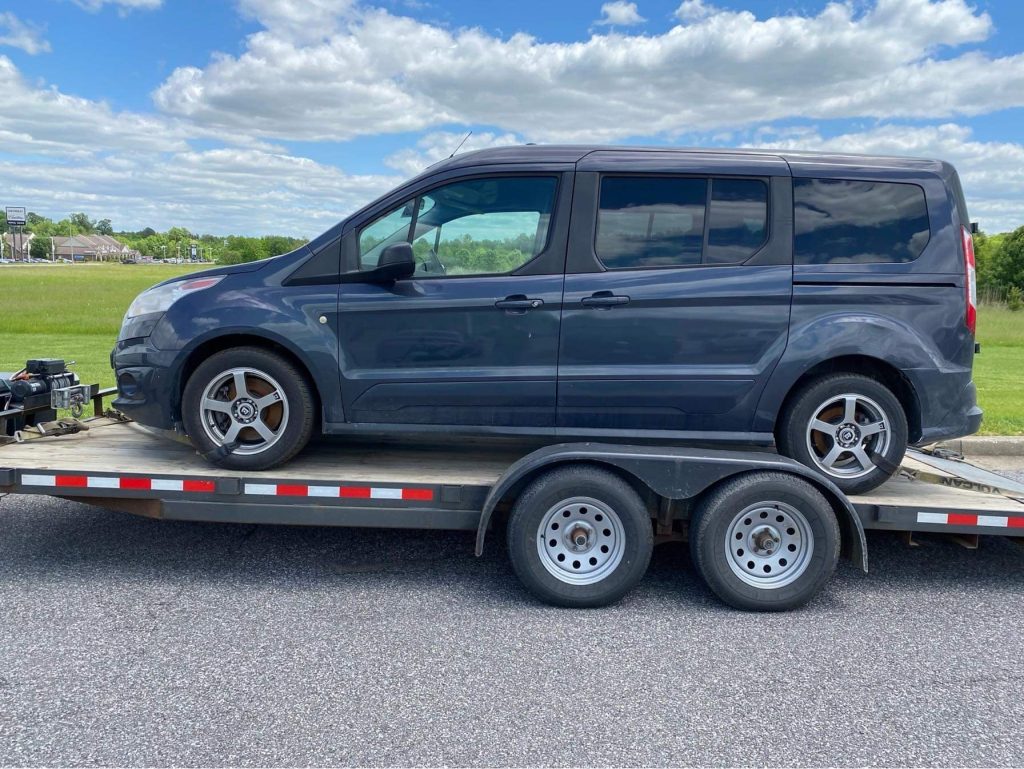April 21, 2021. Approximately 3:30 pm, 4 miles north of the Illinois-Kentucky border on Interstate 24.
I was about halfway through my ~8 hour drive, just passing through some construction traffic when it happened–first, a little lag between shifts, then pretty quickly I was essentially in neutral, lucky to make it to the end of the barricades and onto the shoulder. No codes or warning lights, but any attempt to move at anything more than idle speed was out of the question.
I quickly called for a tow, and contacted the closest Ford dealer (in Paducah) with the hopes that a quick look could determine whether it might be a simple fix or if a rental car for the rest of the trip was in order. After barely making it there before closing time, it was clear we were talking about the latter. I reserved a rental car at the Paducah airport, and Milo and I hitched a ride from the dealer’s shuttle driver.
The next day, the diagnosis was as expected–the transmission had failed internally, with pieces of clutch material and other stuff coming out when the drain plug was removed. The good news was that we knew what the problem was, the bad news was that they had no sources for a remanufactured or new transmission from Ford or otherwise. The estimate was over $5,000 to purchase and install a used transmission.
Why did it fail?
It’s worth discussing why I think the transmission failed, and why this wasn’t totally unexpected. Beginning on the pre-purchase test drive, the van had an occasional harsh shift–we knew it would fail at some point, it was merely a question of how and when. It also had a fairly low level in the coolant reservoir, without any signs of leaking. Related? I think so.
While this 2.5L iteration of Ford’s Duratec 4-cylinder is arguably one of the most reliable out there, it does have one serious flaw: an occasional hairline crack between cylinders 2 and 3 that allows just a little bit of coolant loss. We’re talking about topping it off once a year or less probably–hardly a driveability concern on its own. However, those low levels mean that the transmission cooler, which is located above the transmission, essentially just below the air intake tube, is easily starved of coolant. We know the van was used in the suburbs of Atlanta to deliver parts, meaning lots of short-ish local trips in stop-and-go traffic and Atlanta heat. One look at the exit from the dealership told me that ~80% of every trip started with a nearly full-throttle launch into traffic, which isn’t exactly the best thing for a transmission.
The early 6F35 also had a flaw of its own. The transmission case wasn’t stiff enough around the driver’s side axle seal, allowing some flex and minor leakage between the seal and the case. In decades past, where one might check fluid level with a dipstick or notice a drop or two on the pavement, this might be easy to notice and stay on top of. But like many modern vehicles, there’s an absorbent engine splash shield (soaking up small leaks), and checking the fluid level requires taking the driver’s side wheel off.
If we assume it had been operated in that service environment with low coolant and transmission fluid levels over a prolonged period of time, accelerated heat-induced wear of the transmission’s internals would hardly be surprising. The take-away for anyone with a stock Transit Connect is to keep an eye on coolant levels and transmission fluid levels–at a minimum, check both at each oil change, especially if there’s any sign of leaking around the axle seal. If you keep up with both, neither is likely to cause a problem for a long time. If the axle seal leak becomes significant, Ford has a repair kit to beef up the case and prevent future leaks.
Getting the Boot Home
Of course, I wasn’t about to pay almost what I paid for the van to have a used transmission put in. It was either going to have a transmission put in by yours truly, or go through a transformation of sorts that I’d had in the back of my mind for some time–but it sat about 300 miles from the closest place where I could tackle the project.
One option was to rent a car trailer (or dolly), and head down there with an F-150. A 3-valve 5.4L F-150, that was still occasionally having cam phaser knock issues. Another was to pay someone to haul it back–which is what I ended up doing. Since I wasn’t in a huge hurry, I posted on Uship.com and waited for bids to come in. I ended up settling on a one-man show, a retired Marine who had a single-car trailer with a winch. That way we weren’t wasting anyone’s time (or racking up extra charges) if the van couldn’t make it up the ramps on its own. I have nothing but good things to say about that experience, and $500 later the van’s automatic transmission was on it’s farewell tour spanning 3 states.

